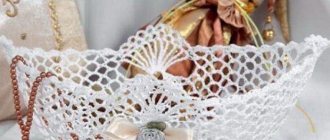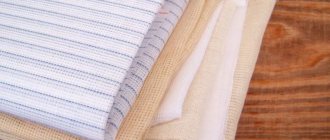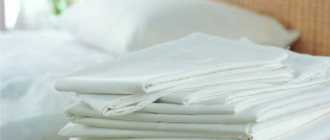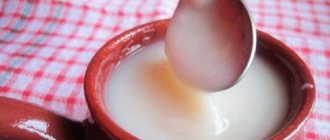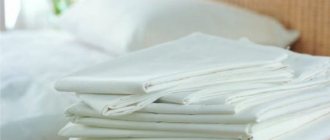Crocheted napkins, tablecloths, curtains are a great addition to the interior. Such details add coziness to the home and add a special flavor. That is why many housewives decorate their apartments with knitted items, making them with their own hands or purchasing them in stores.
Using starch, you can not only smooth napkins and tablecloths, but also give them various shapes, turning them, for example, into openwork plates
Those who know how to work with crochet know that during the knitting process, the fabric of the napkin is stretched and wrinkled. To make the finished product even, it can be washed and ironed. And to achieve an ideal result, it is better to additionally treat the fabric with starch.
Crocheting is the process of creating patterns from threads using a crochet hook
Why starch knitted napkins?
Napkins are knitted using “Iris” and “Snowflake” yarns. These threads make beautiful products that are good for starching. While the product is being knitted, due to the weaving, the napkin becomes wrinkled and does not hold the desired shape. To make it less dirty and tougher, it is recommended to starch it. Thanks to this procedure, the threads are covered with a protective film.
They look thicker, protected from dust and any contamination, while the product:
- becomes dense and elastic;
- slightly bleaches and acquires gloss;
- loses susceptibility to dirt: threads covered with film are not saturated with dust and moisture.
Napkins most often serve as decoration for a coffee table, bedside table, or chest of drawers. Thanks to them, it becomes possible to cover up defects on furniture. After starching, the napkin can be easily turned into three-dimensional objects - a vase or a candy mold. Products made from white threads - cotton or linen, which are easily amenable to this procedure, are most often starched.
Classic method
This method of starching is passed down from generation to generation. It is considered the most optimal and simplest option for imparting rigidity. After using it, the product keeps its shape.
Using potato starch is also the cheapest method, but effective. Grandmothers successfully use it, which inspires confidence in this procedure.
Concentration
The solution can be prepared in several concentrations, it all depends on how hard the product should be.
Crocheted tablecloths can be starched with a liquid with the following concentration:
- Soft - 1 tsp per liter of water. starch. A solution of this concentration is great for napkins and tablecloths that need to hang down. The soft method can also be used for knitted curtains.
- The average concentration of the solution is prepared from 1 tbsp. l. potato starch, which are diluted in 1 liter of water. Great for cuffs, collars, lace doilies.
- Hard concentration is prepared at the rate of 2 tbsp. l. starch per 1 liter of water. This method is used to impart rigidity and hardness. For example, this way you can starch a knitted fruit bowl, plate or yarn flowers. The hard method is also suitable for other voluminous crafts that are crocheted.
These concentrations are suitable if potato starch is used. When using corn, you should know that it is not as viscous, so you will need half as much.
That is, to prepare a solution of soft concentration you will need 1.5 tsp, medium - 1.5 tbsp. l., hard - 3 tbsp. l. The steps for preparing the paste are the same.
Stages of paste preparation
Before using starch, pour it into a separate dry container and check for lumps and debris. If you notice foreign inclusions, do the following: fill the product with water, and after 2 hours use it for starching. All debris will rise to the top, and pure starch will remain at the bottom.
How to prepare the solution correctly:
- Prepare two containers. In the first, starch is mixed with a small amount of water to obtain a creamy consistency. There should be no lumps.
- The remaining water is poured into the second container and placed on the stove. After waiting for it to boil, pour the liquid in a thin stream into a container with prepared starch.
- Then the first container is placed on the fire and brought to a boil. The paste must be constantly stirred to prevent lumps from forming.
- After boiling, remove the container from the stove and leave to cool. The temperature of the paste should be 30–35 degrees.
Now you can starch the knitted napkins.
The process itself
Correctly starching a knitted product is not difficult if you follow the steps of the procedure. Especially when the procedure is performed for the first time.
How to starch a crocheted napkin with starch - algorithm of actions:
- The finished paste is poured into a basin; it must be clean and dry. Take care of this in advance.
- The product is dipped into the liquid, it must be completely saturated with the composition. Remember, if starching is carried out, more solution will be needed for the tablecloth, not 1 liter.
- The product is kept in the composition depending on the thickness of the thread. If they are thin - 7 minutes, medium - 10-15, thick - 15-30 minutes.
- Then the product is removed from the solution, the excess liquid is carefully squeezed out, and laid out on the table.
The napkin must be straightened and given the correct shape. When it becomes slightly damp, iron it through several layers of gauze. The temperature of the electrical appliance should be minimal.
You need to act quickly, and at the same time do not forget to watch the edges of the product so that they do not bend and the appearance does not deteriorate.
If we make a vase from the product, then smooth the soaked napkin onto a bowl of suitable volume and leave it to dry in this form. If possible, then starch it on the selected item.
This method does not require the use of an iron. The product must dry on its own, which takes 24 hours. If the threads are thick it may take longer.
Basic rules and what to prepare for starching
Before you start starching a napkin, you need to:
- Wash. To do this, it is better to first soak knitted items in warm water with the addition of washing powder for hand washing.
- Rub a little with gentle movements.
- Rinse well. If the napkins are knitted from natural fibers, you need to remember: they can shrink, so it is better to use warm water. You should be especially careful with woolen products.
If there are several napkins, they can be washed in the washing machine. After rinsing, it is recommended to start starching. The duration of the procedure largely depends on the thickness of the yarn. If it is thin, then the napkin is placed in the prepared paste, this procedure lasts about 5 minutes, when thick yarn is used, the time is 10 minutes.
Before you starch a crocheted napkin, you need to wash it
Then the product is lightly squeezed and laid out on a flat surface to dry. It is necessary to remember: only when the product is not completely dry, and a slight dampness is felt in it, can the napkin be given the required shape.
You can starch a crocheted napkin using starch or other household ingredients, but before the procedure itself you need to prepare:
- head pins: that is, with beads at the end;
- wire for aligning edges;
- ruler;
- a bowl for the solution;
- spray;
- white paper;
- a towel or white sheet;
- wide brush;
- drying surface;
- mold for bulk products.
PVA glue
A long-term result is one of the advantages of this method, but it is worth remembering that such a solution creates a high degree of hardness and cannot be used for underwear and bed linen.
Napkins properly treated with PVA glue will become elastic and rigid.
It is necessary to prepare a solution in the following ratio: a glass of water and half a glass of glue. This method is relevant when it is necessary to give a clear shape. To do this, dip a crocheted napkin into the mixture, wring it out and, if necessary, pull it into the desired shape.
This way you can create a napkin vase.
Traditional recipe with starch
A frequently used method is starching using potato starch. It is easy to prepare by mixing starch and water. Due to this, the consistency becomes thick, resembling a paste, which will make the product harder and whiten.
How to starch a crocheted napkin - the easiest and most popular way - using potato starch
Some housewives like to use starch obtained from corn or rice. However, to give the greatest thickness, you will have to add much more of this starch than potato starch.
Solution concentration
The hardness of products after starching largely depends on the concentration of the prepared pastes:
| Solution concentration | Preparation |
| Weak | To obtain it, add 0.5 tsp to 500 mg of water. starch. This is applicable so that the napkin becomes too stiff and its edges sag slightly |
| Medium hardness | The solution is obtained by adding 0.5 tsp to 500 ml of water. The napkins come out firm and they hold any shape well. |
| Hard | In this case, add 1 tbsp to 500 ml of water. l. starch. This napkin is easy to make voluminous. It can become a vase for artificial flowers or an openwork bowl |
Starching algorithm
Not everyone knows how to starch a crocheted napkin correctly.
Much depends on the cooking of the paste, the preparation procedure of which consists of the following steps:
- Pour starch into cold water and mix thoroughly so that there are no lumps. If they form, it is recommended to pass it through a sieve.
- Bring the other part of the water to a boil.
- Pour in the starch solution in a small stream, stirring constantly with a spoon.
- Continuing to stir, wait until the liquid boils again.
- Turn off the heat and wait until the paste cools to a temperature of 35° C.
There are cases when starch has impurities, and then when mixed with water, dust particles are formed. To remove impurities, you need to add starch to cold water, wait a little and drain it, then pour it in again, mixing everything, and so on until the water becomes clear.
When starching a napkin, you must follow the following algorithm:
- Pour the cooled paste into a plastic bowl.
- Place a pre-washed napkin in it, making sure that it is completely immersed. If the threads are thin, then the immersion time takes 5 minutes; with an average thickness, 10 minutes is enough. Products knitted from thick threads must be kept in the paste for 15 minutes.
- Remove the product, squeeze it lightly and lay it out to dry on a horizontal surface. You can cover the bottom with a white towel or cotton cloth.
To make the starch more hard, you can add salt, sugar, milk, and talc.
How to starch a crocheted napkin using potato starch
How to starch a crocheted napkin using starch in another simple way:
- Prepare the microwave oven for use.
- Prepare a solution based on 500 ml of water, 1 tbsp. l. starch.
- Place the solution in the oven and heat.
- Remove and mix thoroughly.
- Load the product.
- Place the solution and napkin back in the microwave for 5 minutes.
- Remove and cool to 35°C.
- Wring out the product and lay it out to dry.
If this method is followed, the napkins retain their shape well.
Dry method
You can not soak the napkin in the paste, but treat it in another way. The product will be of medium hardness.
- lay the napkin on a flat surface, you can secure the edges with pins;
- through a strainer, evenly sprinkle the product with starch, trying to cover it evenly;
- spray the products with water from a spray bottle, the starch should be slightly moistened, no more;
- Allow the napkin to dry completely and shake off any excess starch.
When using this method, starched napkins do not retain their rigidity for long, so treatment must be carried out more often than when using conventional soaking methods.
Drying, ironing and storage
It is important not only to properly starch the product, but also to dry it properly. To do this, you need to follow a number of rules.
Getting into the correct position
After the napkin is saturated with the paste, it must be laid out horizontally. For these purposes, use the surface of a table, ironing board, polystyrene foam or the smooth side of a ceiling tile made of foam material.
It is recommended to first lay a white sheet in several layers or a terry towel. The surface must be flat, otherwise the product will take on an irregular shape and will be wavy. It is not for nothing that the fabric is spread so that the napkin can be fixed with pins, about 1 cm thick. It should not get wet, otherwise the product will take a long time to dry.
Giving stillness
The napkin is first soaked in the paste, then laid out, straightened and secured with safety pins, pinning them to the ends of the product. This is necessary so that it does not deform, but has the correct shape.
You can secure the starched napkin using pins
To fix, you need to perform a number of sequential actions:
- Start giving the correct shape from the middle, securing 4 pins to avoid distortions.
- Stretch one tip, measuring the distance with a ruler from the center to the tip, securing with a pin.
- Carry out the same steps with all ends of the napkin. For evenness, it is advisable to take the ends of the napkin located diagonally, constantly measuring the same distances with a ruler. Then the intermediate segments are attached.
Drying
The most optimal condition is when the napkin is exposed to sunlight and the room is well ventilated. In some cases, you have to use an iron, covering the product with gauze or white paper.
If the napkin should be voluminous in the form of a vase or plate, then it is recommended to dry it by placing it on the form, after covering it with film. They can be a glass, bottle or bowl.
It is convenient to use a balloon as a form. It can be inflated in different sizes, but it is also recommended to cover it with cling film before placing a napkin on it. It is necessary to dry until completely dry, sometimes it takes about 2 days.
Ironing
Individual napkins will look aesthetically pleasing after steaming and ironing, for this:
- the iron should not be heated too much;
- iron quickly, being careful;
- To prevent the napkin from turning yellow, cover the product with several layers of gauze.
Storage
It is important not only to dry and iron the napkins, but also to store them correctly. The room must be dry: with high humidity, the products can become moldy, lose their shape , and fungi can grow on them. If sugar was used, insects (ants) may come running.
Products for starching things
To preserve the excellent appearance of the item for as long as possible, and also to keep it in shape and bleached as much as possible, you can use the following ingredients for starching.
Starch
Before use, we need to determine what severity of treatment we need. Next, prepare a solution of rice, potato or corn starch. In a container, mix the starch with a small amount of cold water, then take a second container, pour the solution into it and, stirring, pour in boiling water.
Good to know! If you next need to add blue, the solution must first be filtered so that no lumps form in it. If a hard starch method is used, the solution can be boiled several times so that it becomes as cloudy as possible, and not completely transparent.
Then we send the item into the resulting mixture for a while, and then squeeze it out. If the item is completely white (for example, a scarf), then the starch can be mixed not with water, but with milk.
Sugar syrup
Pour 400 grams of sugar into water, stirring gradually. Place the solution on the fire and bring to a boil until the Sugar is completely dissolved. Then we put the item in the resulting solution, soak it as much as possible, and then wring it out.
If after the procedure part of the product is not completely starched, then it is worth repeating it. Or use an ordinary brush, as if “painting” a knitted item. If it is not possible to achieve the required rigidity, the process is repeated.
Having wrung out the item, straighten it out, pin it to a clean fabric with pins, then lay it out on a horizontal, flat surface, and send it to dry in a warm, well-ventilated place.
PVA glue
To obtain a solution, mix glue and hot water in a ratio of 1 to 1 or 1 to 2. Then the mixture is poured into a liquid sprayer, and the product is thoroughly sprayed. You can also pour liquid into a bucket and send the thing into it.
Milk
In most cases it is used for starching products made from light fabrics.
But, it is important to take only skim milk. You can also add starch to it to achieve a thicker consistency.
Gelatin
1 tbsp. l. gelatin is diluted with 200 ml. cold water and leave until it swells. Afterwards, another 200 ml is added to the container with the substance. boiling water, set aside until completely dissolved.
You can also take a whole bag of gelatin and add 1 tbsp to a glass. l. table salt, and pour the solution into a 0.5 jar of hot water. Then wait until the mixture is completely dissolved.
In both the first and second versions, the product is immersed in a completely cooled solution. An item starched in this way will keep its shape perfectly until the next wash.
Glossy starch
You can buy it ready-made, or prepare it yourself. In addition to hardness, this substance can give any thing a glossy shine. Therefore, it is useful for the most elegant things, as well as tulle with curtains.
Recipe. The substance consists of wheat or rice starch, white talc, and borax powder. The proportions are 5 to 3 to 1. You can take rice starch, borax, boric acid in a ratio of 8 to 10 to 2.
Each of the substances is thoroughly mixed, then diluted into a paste using cold water, and applied to the product using a sponge. After ironing the item, it becomes shiny and durable.
What threads of napkins cannot be starched?
Napkins are knitted from various threads. But only products made from cotton and linen starch well and keep their shape.
Napkins made of woolen threads and floss cannot be starched.
It is not recommended to subject products made from the following fibers to this procedure:
- wool;
- floss;
- silks;
- synthetics.
They will not become rigid; starch does not penetrate well between the fibers of these materials. Silk threads may lose their structure. When starching colored and dark napkins, the natural color will be lost and white spots may appear.
How to starch bedding and clothes in a washing machine
To starch things in the washing machine, you need to add a small amount of adhesive liquid to the conditioner compartment and start the usual washing cycle
Ready-made starching compositions are sold in household chemical stores - some are applied to the fabric before ironing, others during washing. Starching bedding and linen in the washing machine is as easy as shelling pears:
- to begin with, prepare a “soft” starch solution according to the above-described scheme;
- the composition is poured into the engine compartment for the air conditioner;
- The washing machine toggle switch is set to rinse mode;
- after the process is completed, the laundry is taken out, shaken, and dried;
- The machine is wiped from the inside and ventilated.
When starching in a washing machine, special synthetic liquids are often used, for example, based on polyvinyl acetate, which cope with the task no worse. Additionally, you should not use any conditioners.
A starch agent that is added directly during washing
To starch clothes and table linen made from various types of fabric, a solution of the required composition and concentration is prepared and poured into the machine as described above.
Mistakes and recommendations when starching knitted items
Many housewives make mistakes when starching products. Napkins lose their appearance, become covered with yellowness, dark items become covered with white spots.
Colored napkins should not be starched - they will become stained
It is advisable to adhere to the following recommendations to avoid mistakes:
- When it becomes necessary to starch snow-white napkins, it is better not to use starch and gelatin, because over time they turn yellow. It is better to use skim milk with rice starch.
- If the napkin is knitted from colored or dark threads, it is better not to starch it so that it does not become covered with whitish spots and stains.
- Products knitted from synthetics should not be starched. They can stretch and lose their correct shape.
- It is best to purchase a ready-made starch product in the form of an Aerosol.
- It is not recommended to store a starched napkin in a closet for a long time; it may turn yellow.
- It is necessary to remember: after treatment with starch, the item cannot be moistened, it will lose its shape, and everything will have to be done again.
- If the edges of the napkin are decorated with fringe so that it does not stick together, then it should be held over steam, then combed with a comb.
- To give the napkin a wave shape, you need to wrap it around a bottle or thick curlers.
- When using a hot solution, the product turns out to be solid.
- To iron a napkin without it sticking to the iron, you need to add skim milk instead of water.
- To make the item soak in the paste faster, it is recommended to put the bowl with the item in the microwave for 5 minutes.
You can give a starched napkin the desired shape using curlers and other improvised means.
If you like to add coziness to your rooms using crocheted knitted accessories, then you must know the technique of starching products. To starch a napkin, you need to choose the appropriate method.
When giving the product a three-dimensional shape, it is advisable to use starch with the addition of sugar, salt, gelatin, and PVA glue. It is important to maintain its whiteness, shape, fix it and dry it well. Only if you follow an algorithm of thoughtful actions will the product please you with its appearance.
Article design: Natalie Podolskaya
Cold way
This method can be used if there is no need to give the product increased rigidity. Procedure:
- Stir starch in cold water, the proportions are the same as when preparing the solution using the hot method;
- stir thoroughly, you should get a suspension without lumps, if this cannot be achieved, you need to strain the solution through a sieve;
- place the product in a cold solution for 30-40 minutes;
- squeeze and dry, giving the napkin the desired shape.
After this treatment, the napkin will remain soft, the material will only be slightly compacted.
